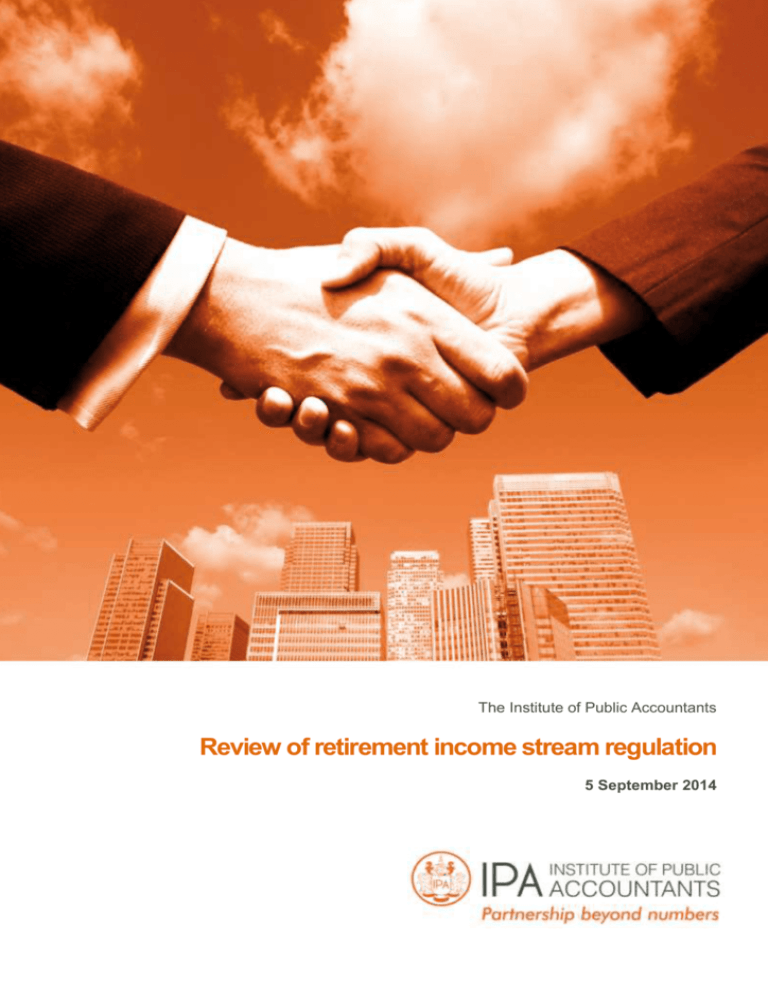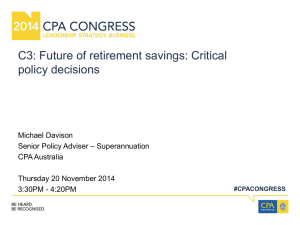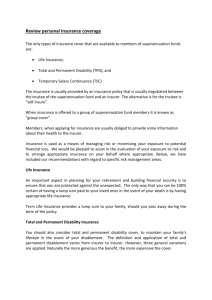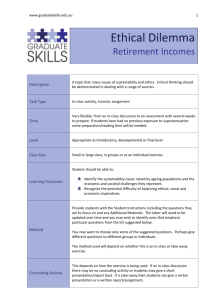
The Institute of Public Accountants
Review of retirement income stream regulation
5 September 2014
Introduction
Benefits and Regulation Unit - Personal and Retirement Income Division
The Treasury
Langton Crescent
PARKES ACT 2600
Email: superannuation@treasury.gov.au
The Institute of Public Accountants (the Institute) welcomes the opportunity to provide input into the
Treasury’s review of the retirement income stream regulation and looks forward to working with the
Government as it establishes an appropriate retirement income system for Australia in the near future.
There is universal support that Australia has one of the best superannuation systems in the world
primarily due to its mandated employer contributions and self-managed superannuation funds.
However, as acknowledged in the Cooper Review, the primary purpose of any superannuation system
is not the accumulation of funds but rather the provision of retirement incomes and long-term reduced
retiree reliance on government financial support.
We applaud Treasury for initiating the debate, through the release of its Discussion Paper, on
developing policies which will ensure that when retirement is reached; monies have been wisely
invested to ensure that adequate funds are available to at the very least defer demands on the public
purse.
The Institute is one of the three professional accounting bodies in Australia, representing over 26,000
accountants, business advisers, academics and students throughout Australia and in 57 countries
worldwide. The Institute prides itself in not only representing the interests of accountants but small
business, its owners, employees and their advisers.
The Institute takes an active role in the promotion of policies to assist the small business and SME
sectors, reflecting the fact that two-thirds of our members work in these sectors or are trusted advisers
to small business and SMEs.
Accordingly, this submission has been prepared in the context of the Institute’s ongoing advocacy on
behalf of the various stakeholders within Australia’s small business community and provides direct
responses to the range of consultation questions contained within Treasury’s Discussion Paper.
The Institute encourages the removal of impediments to developing viable annuities and other longterm retirement income streams. We believe the current tax free status of superannuation benefits and
the ability of retirees to draw down the full amount as a lump sum and without restriction as to use;
severely undermine the underlying policy intent of superannuation. The Institute therefore argues that
policies need to be adopted that encourage retirees to take annuity or pension products upon
retirement.
We welcome the opportunity to discuss our recommendations in more detail with the Government and
Treasury. Please address all further enquires to our General Manager – Technical Policy, Tony Greco
tony.greco@publicaccountants.org.au or (03) 8665 3134.
Yours faithfully
Vicki Stylianou
Executive General Manager, Public Affairs
Institute of Public Accountants
COPYRIGHT
© Institute of Public Accountants (ABN 81 004 130 643) 2014. All rights reserved. Save and except for third party content,
all content in these materials is owned or licensed by the Institute of Public Accountants (ABN 81 004 130 643).
2
Review of retirement income stream regulation September 2014
Table of Contents
Introduction .............................................................................................................................................. 2
Table of Contents .................................................................................................................................... 3
1.0 The regulatory arrangements for superannuation income streams .................................................. 4
2.0 Deferred lifetime annuities................................................................................................................. 5
3.0 The minimum payment amounts for account-based income streams .............................................. 6
4.0 Appendix for response to question 12 ............................................................................................. 10
Contact .................................................................................................................................................. 13
3
Review of retirement income stream regulation September 2014
1.0 The regulatory arrangements for superannuation income streams
Question 1: What types of income stream products would enable retirees to better manage risk in the
retirement phase (in particular longevity risk and investment risk)?
As the Treasury’s Discussion Paper highlights, lifetime income streams insure the holder against both
investment and longevity risk whilst the holders of account-based income streams bear all the
investment risk themselves. The Institute of Public Accountants is concerned that these income
streams will not suit the investment risk profiles for all individuals and would encourage Treasury to
allow holders some flexibility with their investment choices, like they currently enjoy in the
accumulation phase.
The Institute of Public Accountants believes that the longevity risk of account-based income streams
could be managed by the setting of a maximum drawdown rate (that is, not 100 per cent of funds can
be withdrawn immediately when all conditions of release are satisfied), together with a taxation
inducement to drawdown closer to the minimum rate. The Institute would encourage soft inducement
rather than compulsion.
Question 2: Do the annuity and pension rules constitute an impediment to the development of new
products and if so, what features of the rules are of most concern from a product innovation
perspective?
The Institute of Public Accountants believes that the current annuity and pension rules do constitute
an impediment to the development of new products. The Institute is particularly concerned with the
current ability to withdraw benefits in full as a lump sum. This imposition creates high liquidity risk
upon product providers who already have high set-up costs in establishing and marketing new
products.
Question 3: What changes could be made to the annuity and pension rules to accommodate a wider
range of income stream products while having regard to the need to protect against abuse of the
earnings tax exemption and to promote appropriate and prudent retirement income objectives?
Further to our response in question 2, the Institute recommends the re-introduction of maximum
drawdown payments for pensions. Please refer to Table 3.2 and accompanying commentary in our
response to question 12 for further details in respect to this recommendation.
As stated above in our response to question 1, the Institute prefers soft inducement rather than
compulsion and hence would encourage amendment to existing taxation laws that would encourage
individuals to receive a pension rather than take benefits as a lump sum. As such, the Institute
recommends the age threshold of 60, whereby any lump sum withdrawn by those aged less than 60 is
tax free up to a cap, which is currently $180,000, be removed. In other words, any lump sum in
excess of a member’s life time low rate cap, irrespective of their age, will be taxed at the same rate
(currently 16.5 per cent) as anyone under age 60.
The Institute recommends that tax rules around superannuation income stream products that don’t
satisfy the current earnings tax exemption, such as deferred lifetime annuities (DLAs), could be
modified so that these products could receive concessional tax treatment that applies to income
derived from superannuation assets supporting income streams.
4
Review of retirement income stream regulation September 2014
The Institute would encourage the removal of these impediments to developing viable annuities and
other long-term retirement income streams. It would be expected that the introduction of some of
these changes would lead to new products being brought onto the market.
2.0 Deferred lifetime annuities
Question 5: Should people only be able to purchase a DLA with superannuation money?
It is the view of the Institute of Public Accountants that it would be appropriate that people should only
be able to purchase a DLA with superannuation monies once a condition of release has been met.
The Institute believes that the ability to purchase DLAs with non-superannuation monies would be
counter-productive to current policy intentions of the superannuation system by encouraging
individuals to keep money outside of the system in the accumulation phase.
Question 7: Should there be an upper limit on the amount that can be invested in a deferred lifetime
annuity?
It is the view of the Institute of Public Accountants that there should be an upper limit on the amount
that can be invested in a DLA. The Institute recommends that the upper limit be the time that will
elapse from the commencement of the DLA to the end of the maximum deferral period expressed as a
percentage of the maximum deferral period (refer to our response to question 9). For example, if a
DLA is invested to commence in 10 years and the maximum deferral period is calculated as 25 years
then the upper limit on the amount that can be invested in a DLA should be 15/25, that is 60 per cent,
of the total superannuation monies available at date of purchase.
Question 8: Should there be a minimum deferral period for a DLA? If so, what would determine the
period?
It is the view of the Institute of Public Accountants that there should be a minimum deferral period for a
DLA. The Institute recommends that the minimum deferral period be expressed as the shorter of 20
years or the number of years to the person’s life expectancy (as determined by reference to the
Australian Life Tables).
Question 9: Should there be a maximum deferral age or period? If so, what should it be?
It is the view of the Institute of Public Accountants that there should be a maximum deferral period for
a DLA. The Institute recommends that the maximum deferral period be expressed as the greater of
30 years or the period up to ten years past the person’s life expectancy (as determined by reference to
the Australian Life Tables). In other words, the Institute recommends a maximum deferral period of ten
years longer than the minimum deferral period.
Question 10: Do the payment features described in paragraphs 51 and 52 strike the right balance in
allowing people to insure against longevity risk while avoiding unnecessary restrictions on product
development?
The payment features described in paragraphs 51 and 52 in relation to commutability and annuity
payments appear to provide an appropriate balance in allowing people to insure against longevity risk
while avoiding too many restrictions on product development. The Institute encourage the limitation of
5
Review of retirement income stream regulation September 2014
the number of impediments to assist with the development of viable annuities and other long-term
retirement income streams.
Question 11: Should providers of DLAs be able to offer a death benefit? If so, should there be
restrictions on the size of the death benefit that could be offered? If so, what restrictions?
It is the view of the Institute of Public Accountants that providers of DLAs be able to offer a death
benefit as this addresses an impediment for people being concerned about purchasing these products
several years in advance. Research indicates that those individuals that are conservative when
predicting their own life expectancy. That is, on average individuals expect that they will die before
their life expectancy as determined by the Australian Life Tables. With this pessimist outlook of their
life expectancy, it is not unexpected that individuals would be cautious in purchasing products which
do not offer a death benefit to their estate.
The Institute recommends that there should be a limit on the size of a death benefit with it not
exceeding the original purchase price of the product less the total of all, if any, payments paid to the
holder. Such a measure would act as a deterrent for those considering using DLAs for the primary
estate planning purpose of compounding tax-free investment returns in the deferral phase.
3.0 The minimum payment amounts for account-based income streams
Question 12: Are the current minimum payment amounts for account-based products appropriate to
achieve the objectives outlined above, given financial conditions can change?
It is the view of the Institute of Public Accountants that the current minimum payments amounts for
account-based products are not appropriate to achieve the objectives outlined in the Treasury’s
discussion paper given that financial conditions can change. Since its introduction in 2007, there have
been five financial years (out of the past seven), where drawdown relief has been afforded to
pensioners. Accordingly, given this majority of years with drawdown relief has been afforded, the
Institute recommends that the current minimum payment percentages for those receiving a pension be
reduced.
Similar to the minimum payment percentages for 2011-12 and 2012-13, the Institute recommends that
the minimum payment percentages should be set at 75% of current levels as shown in Table 3.1. The
Institute also recommends that the age for the first category be set to the qualifying age of the Age
Pension as this will increase to age 67 in 2027 and subsequently age 70 by 2035.
Table 3.1: Proposed minimum payment percentages (based on current minimum payment
percentages)
Age
Minimum payment
Proposed minimum payment
percentage
percentage
Under 65
4
3
65-74
5
3.75
75-79
6
4.5
80-84
7
5.25
85-89
9
6.75
90-94
11
8.25
95 or more
14
10.5
6
Review of retirement income stream regulation September 2014
Further, the Institute recommends that members should be limited from having the ability to effectively
take 100 per cent of their benefits as either a lump sum or as one off pension payment. Whilst
extensive legislation exists to regulate how much, and the manner in which Australians contribute to
superannuation, limited legislation exists relating to how Australians withdraw their superannuation
once they have retired or reached 65 years of age. Accordingly, Australians are free to do as they
please with their superannuation upon meeting certain conditions of release. ABS data from 2007
shows around 60 per cent of retirees take either a partial or total lump sum. Of this group only 40 per
cent invested in a pension product (an annuity or life pension) or an income earning product (bank
account). Around a third of all retirees used the lump sum to pay off a mortgage, while 16 per cent of
males purchased a new car.
It is the Institute’s view that the use of retirement funds in this manner is not always appropriate and
does little to diminish the future pension burden faced by a shrinking workforce and aging population.
The Institute supports choice in superannuation decision making, but also believes there needs to be
suitable incentives which encourage retirees to invest in pension and annuity products. Annuities will
generally better provide for the longer term needs of retirees and protect against cost of living risks.
Annuities are also clearly more closely aligned with the policy intentions of the superannuation system.
Consistent with the findings and reform proposals of the Henry Review, the Institute recommends
amendments to taxation and superannuation laws to encourage the development and uptake of
annuity products, but not to make it compulsory.
The institute also recommends the age threshold of 60, whereby any lump sum withdrawn by those
aged less than 60 is tax free up to a cap, which is currently $180,000, be removed. In other words,
any lump sum in excess of a member’s life time low rate cap, irrespective of their age, will be taxed at
the same rate as anyone under age 60 which is currently 16.5 per cent.
As those taking a transition to retirement income stream (TRIS) are subject to maximum draw down
amounts, the Institute believes legislation should be introduced to apply a maximum draw down
amount to all pensions, with any excess withdrawals taxed at 16.5 per cent. As there is currently no
limit on how much can be withdrawn by those receiving a pension, in the absence of a maximum
pension drawdown, any legislation to tax lump sums in excess of a low rate cap could be
circumvented with members withdrawing the entire superannuation balance as a pension. Similar to
the current TRIS rules, the Institute recommends that the maximum payment percentages should be
set at two and half times of the minimum payment percentage as shown in Table 3.2.
Table 3.2: Proposed maximum payment percentages (based on current minimum payment
percentages)
Age
Under 65
65-74
75-79
80-84
85-89
90-94
95 or more
7
Minimum payment
percentage
4
5
6
7
9
11
14
Proposed maximum payment
percentage
10
12.5
15
17.5
22.5
27.5
35
Review of retirement income stream regulation September 2014
These recommendations expose the government to minimal incremental costs which would be
needed to implement reforms and provide public education around the changes.
However savings could be substantial. With reference to 2007 aggregates; around 70 per cent of fund
members were in a default super fund. Of this group, half had drawn more than 25 per cent of their
balance as a lump sum. In so doing, this group were more likely to move to a government pension
early in retirement. Measures which encourage default fund (such as MySuper) account holders into
annuity and life pension products are, we believe, likely to lead to significant pension savings.
Question 13: Should there be an automatic mechanism for adjusting the minimum drawdown
amounts in response to significant adverse investment market performance? If so, what should that
mechanism be? How would this also satisfy the rationale for setting minimum payment amounts?
The Institute of Public Accountants believes that there should be an automatic mechanism for
adjusting minimum drawdown amounts in response to significant adverse investment market
performance. The Institute recommends two possible mechanisms. The first mechanism is when
there is a ‘correction’, that is a reverse movement of at least 10 per cent, in the stock market as
determined by reference to the primary index of the Australian stock market, the ASX 200 index. The
second mechanism is when there is a fall in the Reserve Bank of Australia’s Cash Rate greater than
100 basis points. The rationale for this second mechanism is primarily due to there being a high
number of retirees with conservative or cautious investment strategies who would have their income
levels directly affected with a reduction in interest rates.
In the event of a significant adverse market event, the Institute recommends that the minimum
payment percentage be reduced by the existing factor for those under the qualifying age for the Age
Pension (currently 3%). That is, for those under age 65, the minimum payment percentage would
reduce to 0% as shown in Table 3.3. The rationale for this recommendation is that this category of
individuals are likely to have their balances at the highest level post-retirement and are most
vulnerable for larger dollar losses as a result.
Table 3.3: Proposed minimum payment percentages after an investment shock has been
triggered (based on proposed minimum payment percentages from table 3.1)
Age
Under 65
65-74
75-79
80-84
85-89
90-94
95 or more
8
Proposed minimum payment
percentage
3
3.75
4.5
5.25
6.75
8.25
10.5
Proposed minimum payment
percentage after investment
shock
0
0.75
1.5
2.25
3.75
5.25
7.5
Review of retirement income stream regulation September 2014
Question 14: Should the minimum drawdown amounts also increase in response to very strong
market performance? Would the mechanism be similar to that for decreases? Would this satisfy the
rationale for setting minimum payment amounts?
The Institute of Public Accountants does not believe that there should be an upward adjustment to
minimum drawdown amounts in response to very strong market performance. The rationale for this is
fourfold. First, it is expected that a lot of retirees may not directly benefit from strong market
performance based on having a conservative or cautious investment strategy which has little to no
exposure in equities. Second, the individuals already have the flexibility/freedom to voluntarily
withdraw higher amounts than the minimum percentage set by regulators. The election to only receive
the minimum amount assists with managing longevity risk. Third, the minimum payment is
calculated/reset each financial year based on the opening balance of the pension assets, so a higher
drawdown amount would automatically occur in instances where returns were greater than
withdrawals in the prior year. Fourth, history shows that where there are ‘bubbles’ in the market, they
are closely followed by ‘corrections’. The real possibility of having three different minimum payment
percentages across three consecutive financial years would add more public confusion and
uncertainty, resulting in a greater reluctance to enter into these retirement income stream products in
future.
Question 15: For how long should the change remain in place? Should it be left in place only for the
year in which the shock occurs, or until balances have ‘recovered’ by a particular event?
It is the view of the Institute of Public Accountants that change to the minimum payment percentages
should be in place for a year after the recovery of the particular shock, as determined by the
mechanism put in place to measure such shocks (with the ASX 200 Index being the Institute’s
recommendation in response to question 13). That is, say if it takes two years for the ASX 200 Index
to return to prior levels, then the Institute recommends three years for the change to remain in place.
The rationale for this response is twofold. First, individuals will still have the option to voluntarily
withdraw a higher amount than the minimum percentage set by regulators based on their own
particular circumstances and needs. Second, returns from a diminishing asset base will take longer to
recover than if the asset was left wholly untouched.
9
Review of retirement income stream regulation September 2014
4.0 Appendix for response to question 12
Rationale and discussion paper: Soft compulsion for purchase of annuity and pension
products by retirees
The Institute believes MySuper account holders should be encouraged to invest the majority of their
retirement benefits into an annuity or another similar pension product.
The Institute believes that:
this better reflects the underlying intention of a robust superannuation scheme; being the
promotion of financial independence for retirees and reduced reliance on the State;
this is consistent with compulsion which currently underpins the MySuper system; and
Soft-compulsion will ultimately promote better member outcomes and is better public policy.
Superannuation system rationale
The primary purpose of any superannuation system is not the accumulation of funds but the provision
of retirement incomes and long term reduced retiree reliance on government financial support.
This purpose was formally acknowledged in the Super System Review – Final Report “...the retirement
phase of a person’s participation in the superannuation system is the key purpose [emphasis added]
for the accumulation of superannuation savings.”
It is accordingly incongruous that the current superannuation system is largely focused on the
accumulation phase with very little policy addressing the retirement or benefit phase.
A key driver behind the establishment of the superannuation system was recognition that an ageing
population would place significant financial stress on Federal governments in the near future.
The Intergenerational Report of 2010 forecasted that by 2030 the costs of the government age
pension and health care for the elderly would push governments into fiscal deficit. As a proportion of
Australian GDP; health care, aged care and pensions will increase from 8 per cent in 2010 to 13 per
cent in 2030. The government share of GDP was expected to rise from 22.4 per cent in fiscal 2016 to
27.1 per cent in 2049/50.
Furthermore, the number of people employed to those not working is expected to fall from around 5 to
1 today to 2.7 to 1 by 2050. These figures at their most basic point to increased reliance on welfare;
funded by a proportionately declining working age population shrinking workface and relative falling
taxation base.
If we accept that the principal policy intent of superannuation is to reduce the future costs of
government funded pensions, it must also be accepted that current governments must develop
policies which will ensure that when retirement is reached; monies have been wisely invested to
ensure that adequate funds are available to at the very least defer demands on the public purse. We
do not believe that current policy does this.
We believe the current tax free status of superannuation benefits and the ability of retirees to draw
down the full amount as a lump sum and without restriction as to use; severely undermine the
underlying policy intent of superannuation.
The Institute therefore argues that policies need to be adopted that encourage retirees to take annuity
or pension products upon retirement.
The fiscal gap caused by an ageing population can be ameliorated by appropriate government policy.
This can be shown by changes in the projected fiscal gap between the 2007 Intergenerational Report
and those projected in the 2010 Intergenerational Report. In the 2007 report the fiscal deficit was
10
Review of retirement income stream regulation September 2014
projected to commence in 2025, five years earlier than the 2010 report. The major reason for this
change was changes to superannuation policies between 2007 and 2010.
We are of the view that the fiscal impact of an ageing population can be further ameliorated by
ensuring that a large cohort of the retiring population are encouraged or incentivised to draw an
annuity or other pension product.
Soft-compulsion
Compulsion is a fundamental facet of Australia’s superannuation system. It is recognised that while
people accept the need for retirement savings, many would not do so voluntarily without compulsion.
Without compulsion people would likely under-invest in their retirement futures.
The Australian government recognised this earlier than many other jurisdictions. Accordingly, since
1992 contributions towards superannuation have been compulsory. Since that time, minimum
required contributions have risen from 4 per cent to 9 per cent and will eventually reach 12 per cent
from 1 July 2025.
The government has also determined that there needs to be greater compulsion for those it has
designated as the disengaged; being those who place their superannuation into a default
superannuation option. The government has recognised that those in the default system tend to be
disengaged from superannuation and often have little financial literacy. These people would rather
leave things to “the experts”.
To further protect those who make no choice in superannuation and who find themselves in so called
“default funds”, the government limited these default funds to those that have low fees and without
commission. These are the MySuper funds.
Many commentators have consistently questioned why compulsion is required in the accumulation
phase but not in the more important retirement or benefit phase.
The arguments in favour of compulsion in the accumulation phase, are principally that the majority of
people are not sufficiently financially literate to make informed choices and that compulsion protects
their interests; apply equally in the retirement or benefits phases.
The Institute though prefers adopting ‘soft compulsion’ over strict compulsion. The reason for this is
that while it encourages particular behaviour it allows for freedom of choice by those with the capacity
to make their own decisions.
By soft-compulsion in this context we are talking about adopting measures that promote particular
behaviour and discourage other activities without being strictly compulsory.
Soft-compulsion will ensure that people make appropriate investment decisions. The Institute strongly
believes this is necessary in relation to retirement planning for MySuper account holders. Their lower
level of financial literacy and disengagement from superannuation (and investment generally)
indicates they would benefit from limiting their choices when it comes to investing for their best
retirement outcomes. Accordingly, the Institute believes that MySuper account holders must be
encouraged to put a majority of balances in retirement into an annuity or other pension product.
Best interests of account holders
The Institute argues that the best interest for MySuper account holders is for them to invest in annuity
and pension products that will provide financial security in their retirement.
While most economic theories contend that people act in their own best interest, this is often not the
case. The notion of best interest must also be considered in relation to time frames; meaning that
whilst the immediate drawing of a lump sum may be in the short term best interest of a retiree (a
holiday or home payments); in the medium to longer term this may not be the best outcome. It is not
11
Review of retirement income stream regulation September 2014
clear that the vast majority of MySuper account holder retirees will make decisions which are
cognizant of these longer term issues.
The Australian Bureau of Statistics “Survey of Employment Arrangements, Retirement and
Superannuation” indicate that many retirees are not putting their money to the best long term use.
Almost 60 per cent of those who had access to superannuation in retirement had taken either all or
part of their superannuation as a lump sum. Of these, just over 20 per cent invested some or all of
this lump sum into a bank account, personal savings or other investment, while just fewer than 20 per
cent invested in an annuity, approved deposit scheme or other superannuation product.
Further, 34 per cent of men and 27 per cent of women used money from a lump sum payment to
either pay off a mortgage or invest in a new home. Sixteen per cent of men used part or all of the
lump sum to buy a new car and 13 per cent of both men and women used the lump sum to pay off
debts (other than a mortgage).
Around 40 per cent of those who took a lump sum re-invested part or all of that money. More than 60
per cent had spent their lump sum on other than the intended purpose.
Conclusion
The superannuation system was designed to reduce reliance on government pensions and to
encourage self-sufficiency in retirement. While compulsory contributions have increased the funds
people have on retirement, the absence of compulsion in the retirement phase may result in suboptimal choices about how benefits should be used.
We suggest that the disengaged contributor and those in MySuper products should be encouraged
through soft-compulsion to invest an appropriate minimum amount of their benefits into an annuity or
other pension product.
This will result in better outcomes for those members and is in accord with the underlying intent of
superannuation policy.
12
Review of retirement income stream regulation September 2014
Contact
IPA Head Office
Level 6, 555 Lonsdale Street
Melbourne Victoria 3000
Australia
Tel: 61 3 8665 3100
Fax: 61 3 8665 3130
Email: headoffice@publicaccountants.org.au
Website: www.publicaccountants.org.au
IPA Divisional Offices are located in the following cities:
Melbourne
Sydney
Brisbane
Adelaide
Hobart
Perth
Canberra
The IPA has secretariats in:
Kuala Lumpur
Beijing
For enquiries within Australia call 1800 625 625 or your nearest Divisional Office. International
enquiries can be directed in the first instance to IPA Head Office.
13
Review of retirement income stream regulation September 2014









